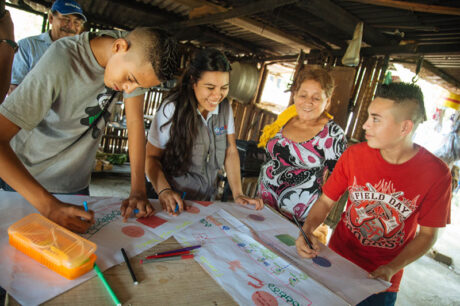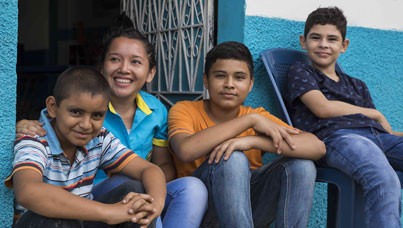An evidence-based, public health approach to preventing youth crime and violence is gaining traction in the Caribbean, where programs are increasingly addressing the underlying risk factors that lead young people to engage in delinquent behavior.
To expand upon this nascent trend, el A NOSOTROS. Agencia para el Desarrollo Internacional Comunidad, Resiliencia familiar y juvenil (CEREZA) Program hosted a Regional Learning Exchange over a series of four webinars between June 24 y julio 16, 2020.
“The work that we do is only successful if a wide cross-section of stakeholders are committed and involved in bringing solutions to development challenges,” said Clinton White, USAID/ESC Regional Representative, setting the tone for the first webinar.
Encima 100 líderes juveniles, policy makers, thought leaders and development partners, representing 17 Caribbean countries, los estados unidos, Canadá, and the United Kingdom, attended each session. Each webinar showcased evidence-based practices implemented in the Caribbean.
“Our hope is that the evidence we share will inform regional action on youth violence prevention policy and programming,” said CFYR’s Chief of Party Debra Wahlberg, opening the first session.
Youth leaders moderated key discussions, examining themes such as applying a public health approach to treat violence in vulnerable communities, building youth resilience, promoting alternatives to crime and violence, addressing unemployment, youth-led advocacy and juvenile justice reform. At the heart of the series was a desire to foster change on a regional scale and equip participants to advocate for better youth-centered policies and services.
Building youth resilience through counseling and psychosocial support
Youth in the Caribbean face steep challenges. Unemployment, lack of opportunity and poor education feed the cycles of violence plaguing the region. Panelists at the conference agreed that these hurdles require a multi-stakeholder, multi-faceted approach.
“In understanding the elements of resiliency, we have finally arrived at a place where we are realizing that changing crime and violence is not simply a matter of limiting guns coming into our country,” said panelist Dr. Kim Scott, Director of the Child Resiliency Programme in Jamaica.
Dr. Scott’s assertion underscores the importance of USAID’s enfoque de salud pública a la prevención de la violencia juvenil. By treating violence like a public health issue, CFYR addresses key risk factors that lead youth to engage in violent behavior in 15 communities across St. Kitts y Nevis, Guyana y Santa Lucía.
Central to this approach is the Asuntos familiares programa. An assessment tool is used to identify youth at the highest risk of engaging in delinquent behavior and then to refer them and their families to Asuntos familiares. Trained counselors spend one year working with ‘at-risk’ juventud, strengthening the family unit and building protective factors to counteract harmful influences. Hasta la fecha, 73 percent of youth participants have experienced a reduction in risk factors, y 56 percent are no longer classified as ‘at-risk.’
“All family members have a voice, which is something that is empowering and validating even to the youngest members of the family,” said Michèle de la Coudray Blake, Director of Counseling in St. Kitts.
Through applying the public health approach and working with families in geographic locations that account for most of the crime and violence within USAID/CFYR’s focus countries, the positive changes achieved are expected to have a significant impact on breaking wider, endemic cycles of violence. The governments of Guyana and St. Kitts and Nevis have adopted the Asuntos familiares programa, independently sustaining the program’s funding and expanding services to new communities.
The USAID/OECS Juvenile Justice Reform Program (JJRP) presented an effective Aggression Replacement Training (ART) intervention that also experienced success involving family and other support systems in individual treatment plans. Other practitioners at the conference echoed the positive impact of counseling, whether cognitive behavioral therapy or trauma-focused counseling, when integrated in violence prevention and youth development programs.
«If a 10-year-old child has a new vision of what his or her life can be, she can break that cycle of violence,» dijo el doctor. Scott.
USAID’s Agency Youth Coordinator Michael McCabe explained that increasing evidence supports the idea that it is essential to address the needs of youth at the intersections of mental health and employability, psycho-social development and education. Programs that incorporate these services often “exceed outcomes in building youth resiliency," dijo.
Positive alternatives to crime and violence and juvenile justice reform
McCabe also emphasized that in youth development work, knowledge and skills-building should be driven by the availability of opportunities in the local context. Without an outlet for youth’s enhanced skills and efficacy, programs can have an adverse effect on development.
«Always start with the opportunities. What is it I want young people to do and how can I connect them to that? Entonces, what skills and how can we help them develop those skills?" dijo.
In Saint Lucia, CFYR facilitated a Hospitality Services Training program, con 74 percent of graduates completing internships in the hospitality industry, receiving international certification, and gaining employment through partnerships with employers. Of the nearly 700 juventud envejecida 16-29 who completed workforce development programs that included life skills training in Saint Lucia and Guyana, encima 400 secured new employment.
CFYR also offered after school programs, providing kids an alternate pathway to growth and a safe space to play and learn skills. These programs had a high retention rate and teachers reported a noticeable difference in students’ behavior and discipline after going through the program.
A major area of concern was also juvenile justice reform and the broader conditions of incarceration in the region.
«Ninety percent of inmates are going to return to the communities in the next 10 años, so we have to prepare our communities to receive them and we have to begin this process early,» said Tavarrie Smith, attorney and founder of Project Youth Justice.
In this area, CFYR developed and updated 21 administrative and diagnostic tools to support rehabilitation and reintegration of youth in conflict with the law in Guyana.
Youth-led peace action and advocacy
The learning exchange included extensive discussion on enhancing youth access, participation and engagement in decision-making and development. McCabe explained how Positive Youth Development approaches not only empower young people to reach their full potential through building skills, assets and competencies, but also through fostering systemic changes that promote their inclusion.
En 2018, youth from across the Caribbean region captured their violence prevention priorities in the Caribbean Youth Defensa & Action Agenda on Violence Prevention (AAA), which was adopted by the regional policy making body CARICOM in early 2019. Turning paper into action, USAID/CFYR developed the AAA Toolkit and online AAA Advocacy course, which is equipping 70 trainees to create a culture of peace.
Dr. Quacy Grant, President of the Guyana National Youth Council and recent AAA Advocacy course graduate, spoke on the connection between youth participation in the electoral process and reducing violence around elections.
He led a voter education campaign in Guyana called InkItUp!, financiado por USAID, directed at engaging young voters while building peace.
“We are hoping to raise a new generation who votes on issues and not on race,” said Grant. “We are hoping that this [proyecto] would bring down the levels of violence around elections.”
Mirando hacia adelante
At the core of the series was the intersectionality of youth violence and the need to interrupt a cycle that connects a range of issues, whether generational intra-family abuse, dificultades económicas, lack of opportunities or voter disenfranchisement. The need to engage young people as equal partners when developing youth violence prevention policies and strategies was made clear.
“There is nothing for us without us,” came the call from Kurba-Marie Questelles, a peace and security specialist who moderated the first webinar.
Building on the learning exchange’s momentum, USAID’s CFYR will share a report that captures key findings and recommendations developed during the four webinar sessions with participants, stakeholders and regional youth-led and youth-serving organizations.
Bringing lasting change and fostering resiliency is ongoing, but programs like USAID’s CFYR and the other programs and stakeholders represented at the virtual Regional Learning Exchange are leaving a legacy that will continue shaping the region’s response to crime and violence.



